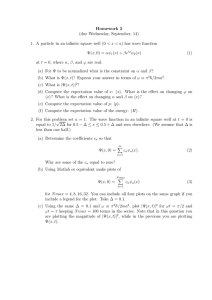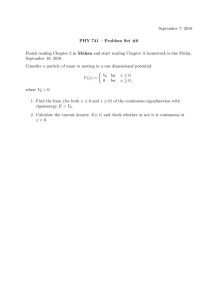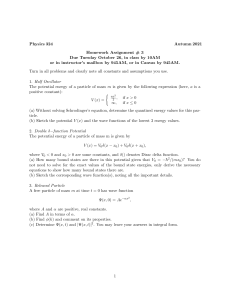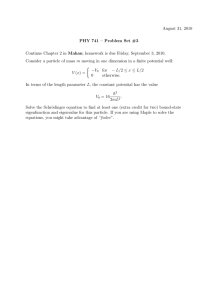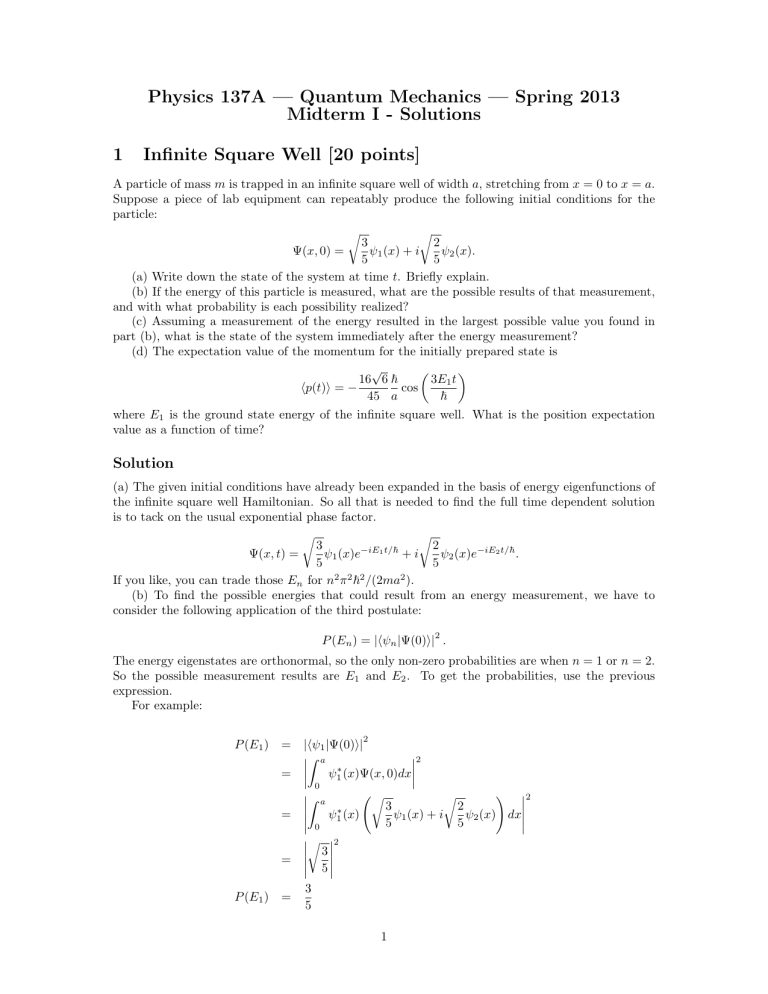
Physics 137A — Quantum Mechanics — Spring 2013 Midterm I - Solutions 1 Infinite Square Well [20 points] A particle of mass m is trapped in an infinite square well of width a, stretching from x = 0 to x = a. Suppose a piece of lab equipment can repeatably produce the following initial conditions for the particle: r r 3 2 ψ1 (x) + i ψ2 (x). Ψ(x, 0) = 5 5 (a) Write down the state of the system at time t. Briefly explain. (b) If the energy of this particle is measured, what are the possible results of that measurement, and with what probability is each possibility realized? (c) Assuming a measurement of the energy resulted in the largest possible value you found in part (b), what is the state of the system immediately after the energy measurement? (d) The expectation value of the momentum for the initially prepared state is √ 3E1 t 16 6 ~ cos hp(t)i = − 45 a ~ where E1 is the ground state energy of the infinite square well. What is the position expectation value as a function of time? Solution (a) The given initial conditions have already been expanded in the basis of energy eigenfunctions of the infinite square well Hamiltonian. So all that is needed to find the full time dependent solution is to tack on the usual exponential phase factor. r r 3 2 −iE1 t/~ Ψ(x, t) = ψ1 (x)e +i ψ2 (x)e−iE2 t/~ . 5 5 If you like, you can trade those En for n2 π 2 ~2 /(2ma2 ). (b) To find the possible energies that could result from an energy measurement, we have to consider the following application of the third postulate: 2 P (En ) = |hψn |Ψ(0)i| . The energy eigenstates are orthonormal, so the only non-zero probabilities are when n = 1 or n = 2. So the possible measurement results are E1 and E2 . To get the probabilities, use the previous expression. For example: P (E1 ) 2 = |hψ1 |Ψ(0)i| Z a = ψ1∗ (x)Ψ(x, 0)dx 2 0 Z r a ψ1∗ (x) = 0 r = P (E1 ) = 3 5 ! r 3 2 ψ1 (x) + i ψ2 (x) dx 5 5 2 3 5 1 2 In the second to last step we have made use of the orthonormality condition on the energy eigenstates. A similar calculation yields 2 . 5 (c) Immediately after the measurement, the state collapses into the eigenfunction associated with the eigenvalue that was the result of the measurement. So the largest energy was E2 with associated eigenfunction ψ2 (x). So right after the measurement (if it was as time t = T , say) is P (E2 ) = Ψ(x, T ) = ψ2 (x). (d) Ehrenfest’s Theorem (which you proved in the homework) says d hxi = hpi . dt So we just need to solve this differential equation: √ 16 16 ~ 3E1 t d hxi =− cos . dt 45 ma ~ m The solution is hxi = C − √ 16 16 ~ ~ 3E1 t sin 45 ma 3E1 ~ If you plug in E1 = π 2 ~2 /(2ma2 ) you find √ 32 6a 3E1 t hxi = C − sin . 135π 2 ~ All that is left is to discover the integration constant C. The symmetry of the problem would require that the expectation value oscillate around the center of the well. So C is a/2. This gives us √ 3E1 t a 32 6a sin hxi = − . 2 135π 2 ~ Note: If anyone goes through and computes hxi directly from the state, you will notice a typo in the problem statement. The denominator should have been a 15 rather than a 45. This had no effect on the solution to this part of the problem. The main point was to use Ehrenfest’s Theorem. 2 Helping a Friend [20 points] Your friend is learning quantum mechanics, and makes the following statements to you. For each, indicate if the statement is accurate or not, and briefly explain why. (a) If I have two independent solutions of the TDSE, I can always take arbitrary linear combinations of them to form a new solution (of the TDSE). (b) If I have two independent solutions of the TISE, I can always take arbitrary linear combinations of them to form a new solution (of the TISE). (c) The result of a measurement is always uncertain in Quantum Mechanics. (d) ĤΨ(x, t) gives the result of measuring the energy at time t. (e) If the expectation value of the energy for a state is E0 , then upon measuring the energy, I am most likely to find energy E0 . (f) I can measure simultaneously the momentum and energy of a free particle to arbitrary accuracy. 2 Solution (a) This statement is true. The TDSE is linear. This means, by definition, that I can take arbitrary linear combinations of solutions to form new solutions. (b) This statement is false. Imagine two solutions to the TISE; which is to say two eigenfunction eigenvalue pairs for the Hamiltonian. Ĥψa = Ea ψa and Ĥψb = Eb ψb . The action of Ĥ on the sum (one example of a linear combination) is Ĥ(ψa + ψb ) = Ĥψa + Ĥψb = Ea ψa + Eb ψb . No matter how hard I work, I cannot make this final expression look like a constant times the initial state. So this is not a solution of the TISE. You may note that if the two states are degenerate (they have the same eigenvalue) then you will be able to write it that way. But the problem asked if this was always possible. (c) This is false. If the state of the system before measurement happens to be in an eigenstate of the operator that represents the observable quantity being measured, then the result is certain. A common example of this is when a system is in an energy eigenstate, then the result of an energy measurement is guaranteed to give the associated energy value. (d) This statement is false. The result of a measurement would be a number. An operator acting on a state will given another state (a function). The results of measurements are the eigenvalues of Ĥ. But Ĥ acting on some general state does not given an eigenvalue. (e) This is false. It is easy to concoct examples where this is not true. If you have a very skewed p.d.f., then the expectation value and the most likely value will not coincide. You can also have a situation where the expectation value is not even one of the possible results of the measurement. (f) This is true. For the free particle, the momentum is related to the energy E = p2 /2m. So measuring p accurately is the same as measuring E accurately. If instead the statement had been about position and momentum then the uncertainty principle would come into play. 3 Finite Square Well [20 points] A particle of mass m is trapped in a finite square well stretching from x = −a to x = a that has seven bound states. Call these normalized bound states ψ1 , ..., ψ7 , and their associated energies E1 , ..., E7 with E1 < E2 < ... < E7 . The potential is zero outside the well and has the value −V0 inside the well (so V0 is positive and real). (a) The initial conditions of the particle, Ψ(x, 0), are such that Z ∞ ψ4∗ (x)Ψ(x, 0)dx = 0.5i. −∞ What is the probability that a measurement of the energy of this particle will yield E4 ? (b) If the only other possible result of measuring the energy is E1 , what is the expectation value of the energy, hHi, in terms of the Ei ? (c) You now measure the position of the particle followed immediately by a measurement of the energy of the particle. If the position measurement gave x = 0, what are the possible results of the energy measurement? Briefly explain. (d) What constraint does the number of possible bound states put on the depth of the well, V0 ? Solution (a) By postulate three, the probability is just the absolute square of the given integral. So if the value is 0.5i, then the probability will be 2 P (E4 ) = |0.5i| = 0.25. 3 (b) If the only other possible energy result is E1 , then it must have a probability of 0.75. So given that one way to write the expectation value is the sum of the probability of a result times the result itself we have 1 3 E1 + E4 . 4 4 (c) Upon measuring the position, the wavefunction would collapse to a spike very near to x = 0. Call this state ψspike . To determine the probability of getting a particular energy when the energy is measured in this state one has to compute the overlap of the energy eigenfunction and the state of the system. So if ψE is the eigenstate with energy E, then hHi = P (E1 )E1 + P (E4 )E4 = 2 P (E) = |hψE |ψspike i| We do not actually have to compute these integrals, because we will make use of integration technique #1. For the bound states, only those that are non-zero at the origin can possibly give a nonzero probability. Given that the bound states of the finite square well alternate between even and odd (with respect to the center of the well) it is only the bound states ψ1 , ψ3 , ψ5 and ψ7 that would give a non-zero probability. Thus, we could get E1 , E3 , E5 or E7 from among the bound states. The scattering states, on the other hand, are all non-zero at x = 0. So all of the scattering states would give a non-zero probability. So in addition to the four bound energies, all of the scattering energies would be a possible result as well. (d) This particular well has seven bound states. The number of bound states is related to the number of solutions of the transcendental equation giving the bound energies. As z0 increased, there were more intersections between the two curves, and thus more solutions. If there are to be seven bound states, four p of those will be even with respect to the center of the well. So the graphs of tan z must intersect (z0 /z)2 − 1 in four places. So z0 must be at least 3π. So ap 2mV0 ≥ 3π ~ or V0 ≥ 9π 2 ~2 . 2ma2 4

